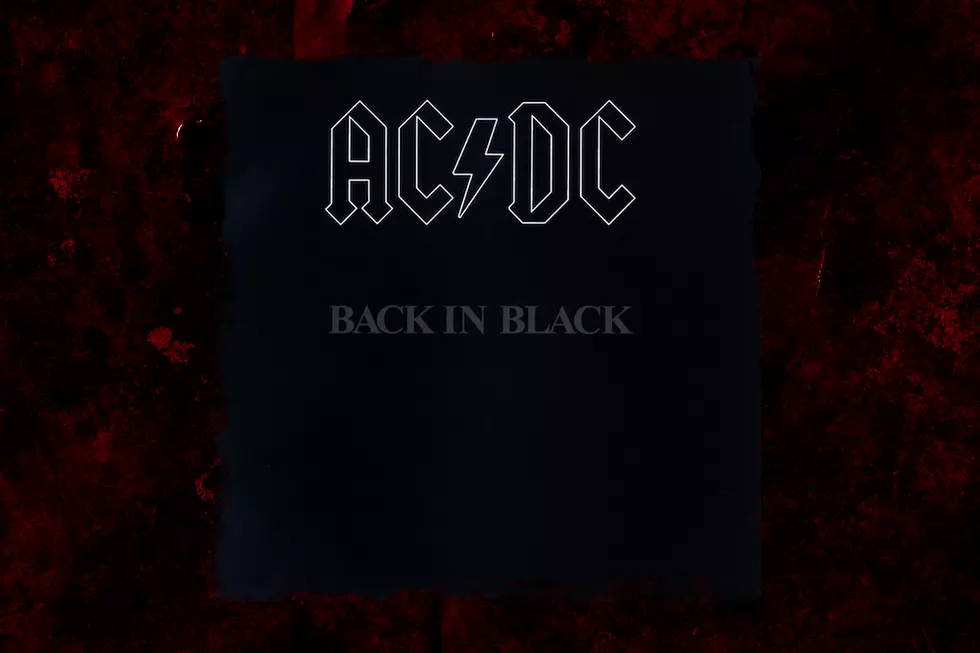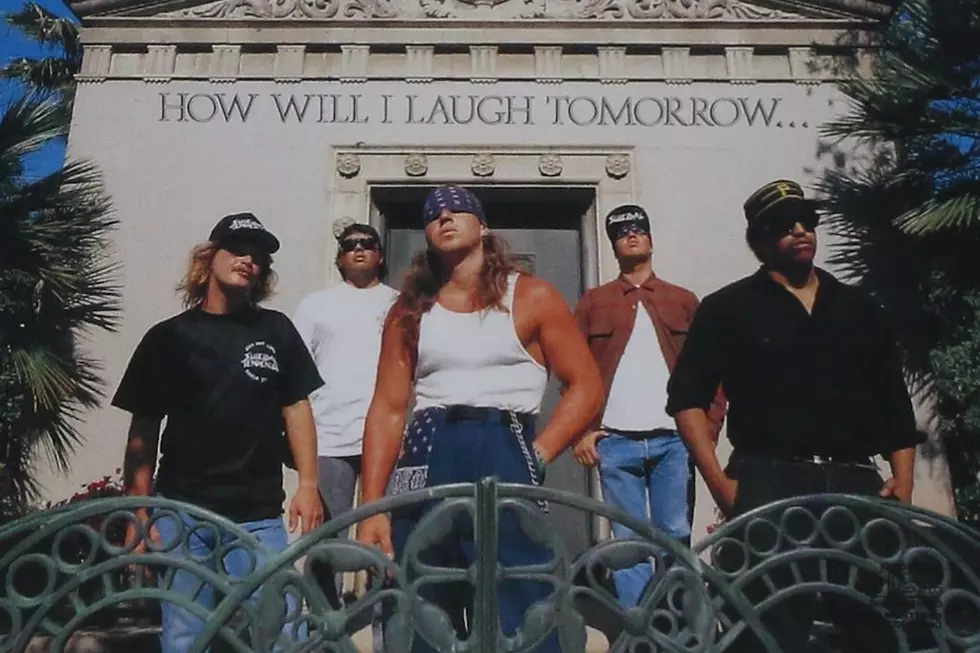
43 Years Ago – AC/DC Overcome Tragedy With the Masterful ‘Back in Black’
When a popular band loses its singer, it rarely bounces back to reach the level of success it had prior to the lineup shift. The most remarkable exception to this rule is Australian powerhouse AC/DC, which released the legendary album Back in Black on July 25, 1980.
The album was dedicated to the band’s late vocalist Bon Scott, who died on February 19, 1980, after a night of heavy drinking. Though they were devastated by the death of their friend and briefly considered breaking up, AC/DC decided to carry on with a new singer. Two days after Scott’s funeral, guitarists Angus and Malcolm Young continued working on new riffs. Angus has said that getting right back to work distracted them from the grief. Soon after, they auditioned singers, including Gary Pickford Hopkins, Easybeats vocalist Stevie Wright and Fat Lip’s Allan Fryer.
Ironically, when Geordie vocalist Brian Johnson (whom Mutt Lange referred to the band) was invited to try out, he wasn’t immediately interested. “Someone phoned up and asked me to join this thing, and I just said, ‘Nah, I’ve been bitten before,’” Johnson told me in 2011. “I had three Top 10 hits with Geordie. And after three years we were as broke as when we started. Those were the days of the great rip off. I was with a company called Red Bus Records, whose motto was, ‘You make the music and we’ll make the money.’ But it was written in Latin so we couldn’t understand it. I just said, ‘I’m not gonna do this again. I was away from home all the time, missed my daughters growing up. But then I got curious and thought, ‘Well, what’s the harm in trying out?’ So I went down, sang with the boys and…. Boing!”
While most other singers auditioned with Deep Purple’s “Smoke on the Water,” Johnson tried out with Tina Turner’s “Nutbush City Limits,” which earned the immediate approval and respect from the band, who were tired of playing “Smoke on the Water” and pleased Johnson listened to different styles of music. On April 8, 1980, following two auditions, Johnson agreed to sign a six-month contract with AC/DC, which would be evaluated after it expired. If at any point during the six months either the band or Johnson decided the pairing wasn’t working out, they could sever the deal. Of course, that was never an issue. Johnson fit AC/DC like a rubber glove.
The band dove right into recording Back in Black with Johnson and Lange at Compass Point Studios in Nassau, Bahamas. For Johnson, who was used to working in a less chaotic manner, it was a trial by fire. The Youngs wrote much of the music in the studio while Johnson worked on the lyrics. AC/DC plowed through six songs, including the title track, which was a triumphant comeback song with slightly sinister lyrics. But when he was asked to write lyrics to a song they wanted to call “Hells Bells,” Johnson hit a wall – until he received some unholy intervention.
AC/DC, "Hells Bells"
“Just then there was the mother of all thunderstorms,” Johnson told Louder Than Hell: the Definitive Oral History of Metal. “I said, ‘Jesus, the noise of the thunder is coming in. Mutt said, ‘There you go, that’s a start, Brian, the rolling thunder.” And I went, “It’s f--king pouring rain, look at the wind, it’s comin’ on like a hurricane. And look at that lightning flashing across the sky!” Honestly, I was like a reporter. There as an alarm bell ringing, so I went, “Got my bell I’m gonna take you to hell. Gonna get ya, Satan get ya! Hells bells.’ That was it. It was ten minutes and the song was done.”
Other numbers, including “Shoot to Thrill” and “You Shook Me All Night Long” came in just a few hours. Without thunderstorms to rely on, Johnson had to use his wits and imagination to help create classics like “Givin’ the Dog a Bone,” “Have a Drink on Me” and “Rock and Roll Ain’t Noise Pollution."
AC/DC, "You Shook Me All Night Long"
READ MORE: The Woman Who Inspired AC/DC's 'Whole Lotta Rosie' May Have Been Found
Like Scott, Johnson enjoyed writing lyrics about partying and double-entendres about sex. And he did so at an astonishing pace. “There was hardly time to think,” Johnson told me. “I’d just go with one idea after another, and any time I got stuck the guys were really patient and supportive. I’d say, ‘No, I just can’t think of anything else. I can’t do it.’ And they’d go, ‘Sure, you can. You’re doing great. Just get some tea then keep going.’ And somehow that always worked.”
Seven weeks after AC/DC started recording Back in Black with Lange, the album was done. “We just started writing and everything poured out of us,” Young said. “I don’t even remember specifics for a lot of the songs. We had almost nothing in front of us one day, and then the next there they were with a finished record.”
AC/DC, "Back in Black"
AC/DC released Back in Black with all-black cover art in tribute to Scott. At first, the record company was resistant, but agreed to the design providing the band outline its name in gray. The album was an immediate success, hitting No. 1 in Australia, the UK and France and reaching No. 4 in the United States. It was an album that only improved with repeat listens, and years after its release it was still selling strong. The first U.S. single “You Shook Me All Night Long” peaked at No. 35 on the Billboard Hot 100 and the title track reached No. 37, yet the album remained on the Billboard chart for 131 weeks.
While Johnson’s vocals were more rooted in soul and blues than Scott’s had been, he had a similar vocal range, and was able to perform all of the band’s best Scott material in concert, staying true to the originals, while augmenting them with his own voice.
“It has been really great because we didn’t have to drop any of them classics,” Johnson says. “We can still do 'Highway to Hell,' 'Whole Lotta Rosie,' 'For Those About to Rock' – any of those great tunes plus all of our new stuff. So we really have a lot of material to pull from every time we play.”
And Back in Black’s usefulness extended beyond its stellar music. Motörhead reportedly used the record to tune their sound system, and because of its pristine production, some studios in Nashville have used it to test the acoustic of a room. In addition, “You Shook Me All Night Long” was one of the songs the U.S. military blasted at the Papal Nunciatura in Panama City on Christmas Day 1989 to convince dictator general Manuel Noriega to surrender.
One more not-so-minor thing to add: Back in Black is one of the biggest selling albums of all time. To date, the disc has sold 22 million copies in the United States and an estimated 50 million around the world.
Loudwire contributor Jon Wiederhorn is the author of Raising Hell: Backstage Tales From the Lives of Metal Legends, co-author of Louder Than Hell: The Definitive Oral History of Metal, as well as the co-author of Scott Ian’s autobiography, I’m the Man: The Story of That Guy From Anthrax, and Al Jourgensen’s autobiography, Ministry: The Lost Gospels According to Al Jourgensen and the Agnostic Front book My Riot! Grit, Guts and Glory.
Top 80 Hard Rock + Metal Albums of the 1980s
More From 92.9 WBUF










